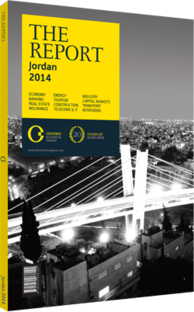Banking
The Company
Arab Bank was founded in 1930 in Jerusalem and was the first private banking institution in the Arab world. In 1948 the bank moved its headquarters to Amman after the start of the Arab-Israeli conflict, where it was officially incorporated as a public shareholding company. In 1978 the bank was the first company to be listed on the Amman Stock Exchange (ASE). With a sound financial reputation and structure, the bank expanded its activities worldwide and opened branches in almost 30 countries covering five continents, making it the most diversified financial group in the Middle East and the largest financial institution in the Arab world in terms of its branch network. Today, around 80% of the bank’s assets are held outside of Jordan.
In Jordan, the Arab Bank is the largest financial institution in terms of both assets, which amounted to $46.4bn at year-end 2013, and market capitalisation, which accounted for 47% of the banking sector’s total market capitalisation and 26% of the ASE’s total capitalisation. A strong domestic and regional presence underpins Arab Bank’s franchise strength.
The bank’s international presence makes it the preferred counterparty for foreign banks conducting business in the region. Arab Bank is the dominant bank in Jordan and Palestine, with shares ranging from 2% to 20% in other MENA countries. Arab Bank’s franchise value enhances the bank’s competitiveness regionally and internationally, and enables it to provide exclusive banking services to its corporate clients, giving it a major positive rating driver.
Diverse Asset Base
The bank’s distinctive feature is the geographic diversity of its assets. The strong franchise of branches, subsidiaries and affiliates complements Arab Bank’s Jordanian operations and reduces the group’s credit and political risks across the Middle East and ensures the solvency of the bank in times of distress. Around a quarter of the bank’s total assets are located outside of the MENA region, demonstrating the presence of real equity in lower-risk countries.
A Proven Track Record
Strong earnings growth in the last decade provides proof of Arab Bank’s high core earnings stability and underpins the group’s robust revenue generating capacity. In particular, the resilience of core revenues during 2009 and 2010 signify the strong operating performance of the bank, which maintained a level of around 2.8% of total assets, despite the escalating political tensions in the region and the weakening global economy at that time.
Despite the fact that Arab Bank’s asset quality indicators are on a weakening trend, and a difficult operating environment in Tunisia, Egypt and Yemen could continue to challenge asset quality, the bank’s size and strong capital cushion will be sufficient to absorb more shocks in the event of future unforeseen losses. In fact, provisioning coverage recently improved to around 94% at the end of 2013, compared to 50.3% in 2009, as the bank increased provisions during 2010 due to sizeable exposures to two troubled Saudi groups.
Arab Bank’s non-performing loans ratio fell to 7% at the end of 2013, down from 8.1% in 2012. Furthermore, the bank’s ratio of gross loans to total deposits remained at a comfortable 66.7% at the end of 2013, suggesting there is room for Arab Bank to leverage its balance sheet. A higher gearing ratio would boost return-on-equity, which currently does not compare favourably with many Jordanian and regional banks.
The central bank’s accommodating monetary policy is encouraged by higher foreign reserves and the improved liquidity of the Jordanian dinar. Increased public spending due to GCC grants should help to stimulate growth and boost credit appetite. However, Arab Bank is a defendant in a series of lawsuits for allegedly providing financial and other support for terrorist organisations. In late September 2014 it was found liable for providing assistance to Hamas in a civil case in the US, although Arab Bank is likely to appeal the decision. Several similar cases are still pending. These could affect the bank’s capital position, putting downward pressure on both its profitability and share price.
You have reached the limit of premium articles you can view for free.
Choose from the options below to purchase print or digital editions of our Reports. You can also purchase a website subscription giving you unlimited access to all of our Reports online for 12 months.
If you have already purchased this Report or have a website subscription, please login to continue.

